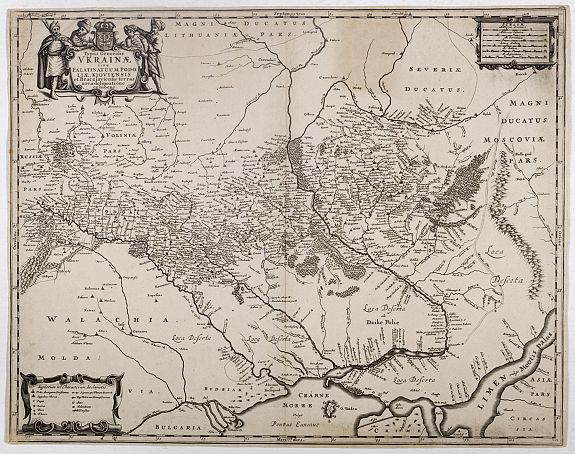Mapping of the Ukraine

Mapping of Ukrainian lands (whose greater part entered the structure of the Polish-Lithuanian Commonwealth) in the 17th century was essentially influenced by the creation of a four-sheet map of the Grand Duchy of Lithuania by Nikolai-Krzysztof Radzivill in 1613.
The main plotter of the map was cartographer Tomash Makovsky. The map covers a considerable amount of territory in Ukraine. Dnepr is represented on an additional inset map on a larger scale; later, this inset map was issued as a separate map. The creation of the map of the Grand Duchy of Lithuania became a significant achievement in the 17th century. Its re-edition of 1631, which entered the atlas of Willem Blaeu, is well-known.
Maps of Ukraine, created based on an instrumental survey, were first issued by French engineer Guillaume Le Vassaire de Boplane. The third version of the General map of Ukraine dates back to 1648, engraved by Wilhelm Gondy as well as the second version of the map of Ukraine from the book “Description of Ukraine”, 1660.
A number of maps were published based on Boplane’s works in the 18th century, like Nicolas Sanson I, 1665, maps of Dnepr by Johann Blaeu, 1662, and four of his one-sheet maps of Braclav, Podol, Kyiv voivodships and Pokutye published in about 1670, maps of such publishers as Johann Baptist Homann, Johann Christoph Weigel, Matheus Seuter, Tobias Konrad Lotter etc.
For the representation of Ukrainian lands in the second half of the 18th century, the map of Poland by Italian Giovanni Antonio Rizzi-Dzannoni in 1772 containing 24 sheets was of exceptional value. The territory of Ukraine is shown on 10 sheets and occupies almost one-third of the territory represented on the map. Though the map was not plotted based on a detailed planning survey, it was actively used for military purposes and the plotting of general developments.
Ukrainian territory, in the structure of the Polish Kingdom, the Grand Duchy of Lithuania and the Polish-Lithuanian Commonwealth is represented by maps from Ptolemy’s “Geography” edition starting from 1482, followed by maps of Italian, Amsterdam, Paris and other publishers of the 16th –18th centuries.
This period is represented by maps by publishers such as S. Munster, T. Makovsky, J. Sandrart, G. Boplane, D. Zvicker, J. Blaeu, P. Duval, N. de Fer, P. Schenk I, J.B. Homann, M. Seutter, G. Sanson, A..Jaillot, T.K. Lotter, J. Ottens, T. Mayer, F.A. Schremble, G. de Jode etc.
Authors of maps of Galichina and Bukovyna, views and plans of Lvov Kamianets-Podolsk etc., when this territory entered the structure of Austria, are G.R. von Schmidburg, R.A. Schults, K. Brown, T. Kratochvil and others.
The territory of the Crimea, Southern Ukraine, the Black sea and states of the Black sea are represented by maps of Blaeu, cartographical publishing house «Sanson’s successors», the Ottens family, Covens and Mortier etc.;
maps of the theatre of military operations between Turkey, Russia and Poland – by the Fascius, Lotter, J.H. Berndt, E. Durie;
maps of the Black sea – by F. Santini, Johannes Jansonius; maps of the States of the Black sea – by J.B. Gomann, M. Seuter, G. Haupt, B. Elwe and other publishers.
The territory of Ukraine is also represented on the maps of Russia published in the 16th – 18th centuries by famous publishers as P. Schenk II, G. Delile, S. von Herberstein, G. Mercator, I. Massa, J. Blaeu, N. Vischer II, M. Merian etc.
Literature.
- Bagrov Leo. Istoriya kartografii / History of cartography. – 2004.
- Sossa R.I. Istoriya kartografyvannya terytorii Ukrainy. Vid naidavnishikh chasiv do 1920 r. / History of mapping of the territory of Ukraine. From ancient times till 1920.–2000.
- DANTISCUM EMPORIUM TOTIUS EUROPAE CELEBERRIMUM. Gdansk i Baltyk na mapach, widokach oraz dokumentach ze zbiorów Tomasza Niewodniczanskiego (Bitburg, Niemcy) / Autorzy katalogu: K. Kozica, J. Pezda. – Gdansk, 2004.
- Imago Lithuaniae / Autorzy katalogu: K. Kozica, J. Pezda. – Vilnius, 2002.
- Imago Poloniae. Dawna Rzeczpospolita na mapach, dokumentach i starodrukach w zbiorach Tomasza Niewodniczanskiego / Autorzy katalogu: K. Kozica, J. Pezda. – Warszawa, 2002. – T. II.